CB2S-J Module Datasheet
Last Updated on : 2024-06-14 18:58:37download
CB2S-J module is a Wi-Fi and Bluetooth Low Energy (LE) combo module developed by Tuya Smart. It is composed of a highly integrated radio-frequency identification (RFID) chip BK7231N and a few peripheral components. It can run in Wi-Fi station mode and access point (AP) mode as well as support connection over Bluetooth Low Energy.
Overview
CB2S-J has a built-in 32-bit MCU with a maximum running speed of 120 MHz, built-in 2 MB flash memory, and 256 KB RAM. The module supports cloud connectivity, and the MCU’s extended instructions for signal processing enable it to efficiently implement audio encoding and decoding.
Various peripherals are available, such as PWM and UART. Up to five channels of 32-bit PWM output make the chip ideal for high-quality LED control.
Features
- Built-in low-power 32-bit CPU that also acts as an application processor.
- Clock rate of 120 MHz.
- Operating voltage range: 3.0V to 3.6V.
- Peripherals: five pulse-width modulators (PWMs) and one universal asynchronous receiver/transmitter (UART) pin.
- Wi-Fi connectivity
- IEEE 802.11b/g/n.
- Channels 1 to 14 at 2.4 GHz.
- Support security protocols including WEP, WPA/WPA2, WPA/WPA2 PSK (AES), and WPA3.
- The maximum output power is +16 dBm for IEEE 802.11b transmission.
- Support STA, AP, and STA + AP combo working modes.
- Two pairing modes are supported, namely Wi-Fi Easy Connect (EZ mode) and access point (AP) mode. Both modes are suitable for pairing with Android and iOS mobile phones.
- The onboard PCB antenna has a peak gain of -0.26 dBi.
- Operating temperature range: -40°C to +85°C.
- Bluetooth connectivity
- Bluetooth Core Specification v5.2.
- The transmitter power in Bluetooth mode is 6 dBm.
- Integral Wi-Fi and Bluetooth coexistence interface.
- The onboard PCB antenna has a peak gain of -0.26 dBi.
Scope of applications
- Smart building
- Smart home and electrical appliance
- Smart socket and light
- Industrial wireless control
- Baby monitor
- IP camera
- Smart bus
Module interfaces
Dimensions and footprint
The CB2S-J dimensions are 25±0.35 mm (W) × 23.3±0.35 mm (L) × 2.3±0.15 mm (H). The following figure shows the dimensions and packaging design of the CB2S-J module.
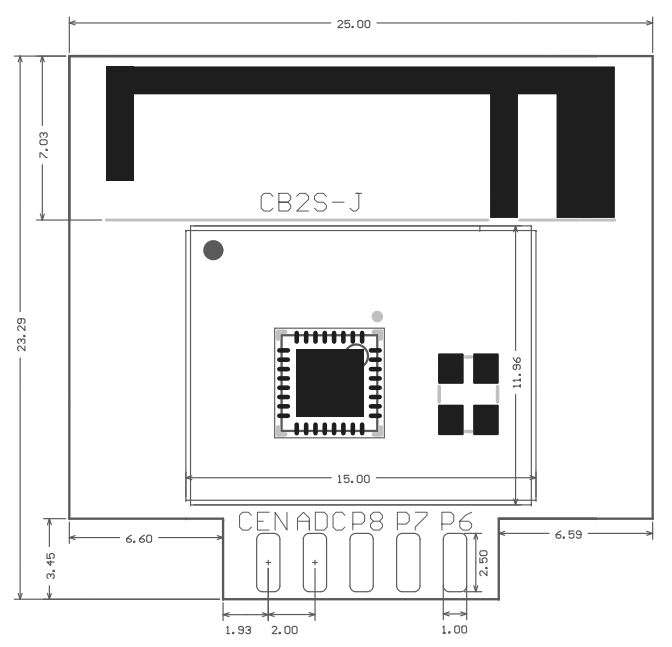
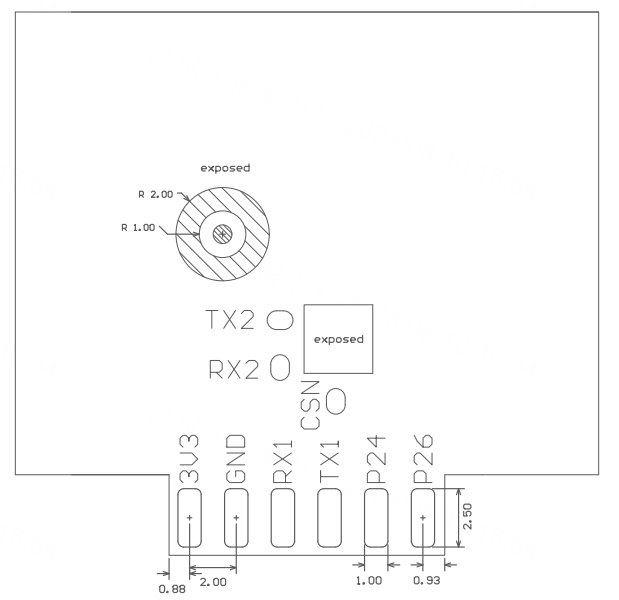
Pin definition
| Pin No. | Symbol | I/O type | Description |
|---|---|---|---|
| 1 | 3V3 | P | 3.3V power pin. |
| 2 | P6 | I/O | Support hardware PWM, corresponding to P6 on the IC. |
| 3 | GND | P | Ground pin. |
| 4 | P7 | I/O | Support hardware PWM, corresponding to P7 on the IC. |
| 5 | RX1 | I/O | UART_RX1 to receive user data, corresponding to Pin 10 on the IC. For more information about MCU general integration, see Hardware Design of CBx Series Modules. |
| 6 | P8 | I/O | Support hardware PWM, corresponding to P8 on the IC. |
| 7 | TX1 | I/O | UART_TX1 to send user data, corresponding to P11 on the IC. For more information about MCU general integration, see Hardware Design of CBx Series Modules. |
| 8 | ADC | I/O | ADC pin, corresponding to P23 on the IC. |
| 9 | P24 | I/O | Support hardware PWM, corresponding to P24 on the IC. |
| 10 | CEN | I/O | Reset pin. |
| 11 | P26 | I/O | Support hardware PWM, corresponding to P26 on the IC. |
| Test point | RX2 | I/O | UART_RX2, corresponding to P1 on the IC. Do not use this pin. |
| Test point | TX2 | I/O | UART_TX2 supports log printing, corresponding to P0 on the IC. |
| Test point | CSN | I/O | Mode selection pin. Pulling CSN down before the module is powered on will start the test firmware, while floating it or pulling it up will start the application firmware. This pin is connected to P21 on the IC. |
Pindicates the power pin, and I/O indicates the input and output pin.- For more information about MCU general integration, see Hardware Design of CBx Series Modules.
Electrical parameters
Absolute electrical parameters
| Parameter | Description | Min value | Max value | Unit |
|---|---|---|---|---|
| Ts | Storage temperature | -55 | 125 | °C |
| VBAT | Supply voltage | -0.3 | 3.9 | V |
| Electrostatic discharge voltage (human body model) | TAMB -25°C | -4 | 4 | kV |
| Electrostatic discharge voltage (machine model) | TAMB -25°C | -200 | 200 | V |
Normal operating conditions
| Parameter | Description | Min value | Typical value | Max value | Unit |
|---|---|---|---|---|---|
| Ta | Operating temperature | -40 | - | 85 | °C |
| VBAT | Supply voltage | 3 | 3.3 | 3.6 | V |
| VOL | I/O low-level output | VSS | - | VSS + 0.3 | V |
| VOH | I/O high-level output | VBAT − 0.3 | - | VBAT | V |
| Imax | I/O drive current | - | 6 | 20 | mA |
| θ | Power supply slope | 100 | - | - | mV/ms |
Radio frequency (RF) power
| Working status | Mode | Rate | Transmit/Receive power | Average value | Peak (Typical) value | Unit |
|---|---|---|---|---|---|---|
| Transmit | 11b | 11 Mbit/s | +16 dBm | 260 | 300 | mA |
| Transmit | 11g | 54 Mbit/s | +15 dBm | 240 | 286 | mA |
| Transmit | 11n | MCS7 | +14 dBm | 238 | 271 | mA |
| Receive | 11b | 11 Mbit/s | Continuous reception | 73 | 82 | mA |
| Receive | 11g | 54 Mbit/s | Continuous reception | 75 | 82 | mA |
| Receive | 11n | MCS7 | Continuous reception | 75 | 82 | mA |
In order to test the transmitting operating current, the module is in the state of sending packets at 100% duty cycle.
Operating current
| Work mode | Status (Ta = 25°C) | Average value | Peak (Typical) value | Unit |
|---|---|---|---|---|
| Quick pairing (Bluetooth) | The module is in EZ mode. The Wi-Fi network status indicator blinks quickly. | 63 | 245 | mA |
| Quick pairing (AP) | The module is in AP mode. The Wi-Fi network status indicator blinks slowly. | 80 | 270 | mA |
| Quick pairing (EZ) | The module is in EZ mode. The Wi-Fi network status indicator blinks quickly. | 78 | 246 | mA |
| Connected | The module is connected to the cloud. The Wi-Fi network status indicator is steady on. | 25 | 342 | mA |
| Weakly connected | The connection between the module and the hotspot is intermittent. The Wi-Fi network status indicator is steady on. | 205 | 350 | mA |
| Disconnected | The module is disconnected from the cloud. The Wi-Fi network status indicator is steady off. | 63 | 242 | mA |
| Module disabled | The module’s clock enable (CEN) pin is pulled down. | 330 | - | μA |
RF parameters
Basic RF features
| Parameter | Description |
|---|---|
| Operating frequency | 2.412 to 2.484 GHz |
| Wi-Fi standard | IEEE 802.11b/g/n (channels 1–14) |
| Data transmission rate | 11b: 1, 2, 5.5, and 11 Mbit/s 11g: 6, 9, 12, 18, 24, 36, 48, and 54 Mbit/s 11n: HT20 MCS0–7 |
| Antenna type | PCB antenna |
Wi-Fi transmitter (TX) performance
| Parameter | Min value | Typical value | Max value | Unit |
|---|---|---|---|---|
| RF average output power, 802.11b CCK mode, 11M | - | 16 | - | dBm |
| RF average output power, 802.11g OFDM mode, 54M | - | 15 | - | dBm |
| RF average output power, 802.11n OFDM mode, MCS7 | - | 14 | - | dBm |
| Frequency error | -20 | - | 20 | ppm |
Wi-Fi receiver (RX) performance
| Parameter | Min value | Typical value | Max value | Unit |
|---|---|---|---|---|
| PER < 8%, RX sensitivity, 802.11b DSSS mode, 1M | - | -88 | - | dBm |
| PER < 10%, RX sensitivity, 802.11g OFDM mode, 54M | - | -74 | - | dBm |
| PER < 10%, RX sensitivity, 802.11g OFDM mode, MCS7 | - | -73 | - | dBm |
| PER < 10%, RX sensitivity, Bluetooth LE, 1M | - | -96 | - | dBm |
Bluetooth transmitter (TX) performance
| Parameter | Min value | Typical value | Max value | Unit |
|---|---|---|---|---|
| Operating frequency | 2402 | - | 2480 | MHz |
| Transmission rate over the air | - | 1 | - | Mbit/s |
| Transmission power | -20 | 6 | 20 | dBm |
| Frequency error | -150 | - | 150 | kHz |
Bluetooth receiver (RX) performance
| Parameter | Min value | Typical value | Max value | Unit |
|---|---|---|---|---|
| RX sensitivity | - | -93 | - | dBm |
| Max RF signal input | -10 | - | - | dBm |
| Intermodulation | - | - | -23 | dBm |
| Adjacent-channel rejection ratio | - | 10 | - | dB |
Antenna information
Antenna type
The CB2S-J module uses an onboard PCB antenna.
Antenna interference reduction
When a PCB antenna is used on a Wi-Fi module, we recommend that the module antenna is at least 15 mm away from other metal components. This can optimize the Wi-Fi performance.
Make sure that the enclosure surrounding the antenna is not traced or filled with copper. Otherwise, the RF performance might be degraded.
Packing and production instructions
Mechanical dimensions
Dimensions of the CB2S-J PCB are 25±0.35 mm (W) × 23.3±0.35 mm (L) × 0.8±0.1 mm (H).
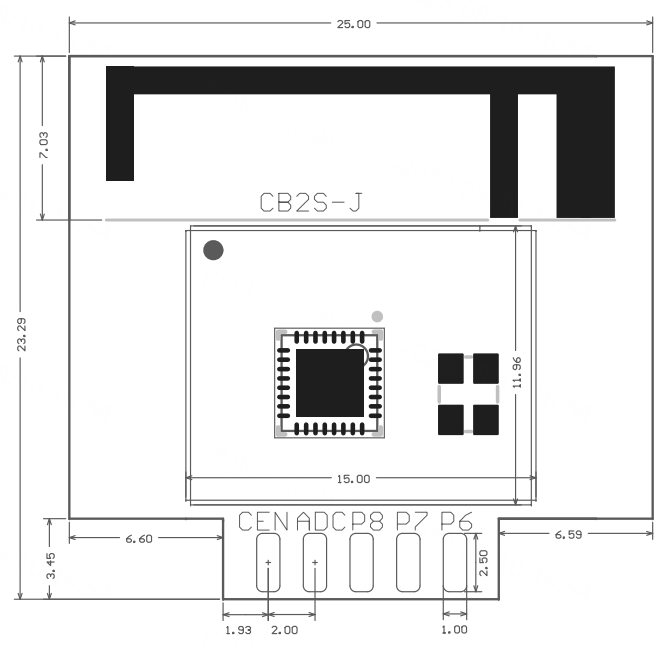

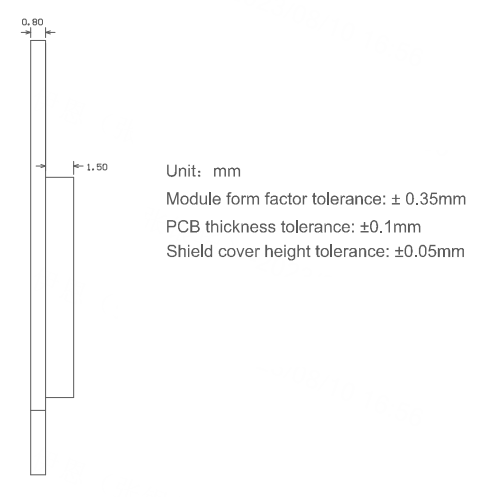
Production instructions
- A wave soldering device is recommended to solder Tuya’s DIP modules. Manual soldering is used only when wave soldering is unavailable. Complete soldering within 24 hours after the module is unpacked. Otherwise, place the module in a drying cupboard with a relative humidity level below 10%, or pack the module in vacuum again. Then, record the packing time and duration of exposure. The total exposure time cannot exceed 168 hours.
- Soldering device and materials:
- Wave soldering device
- Wave soldering fixture
- Constant-temperature soldering iron
- Tin bar, tin wire, and flux
- Thermal profiler
- Instruments or devices required for the baking process:
- Cabinet oven
- Anti-electrostatic and heat-resistant trays
- Anti-electrostatic and heat-resistant gloves
- The module needs to be baked in the following cases:
- The vacuum packaging bag is damaged before unpacking.
- After unpacking, no HIC is found in the packaging bag.
- After unpacking, the HIC indicates a humidity level of 10% or higher. In this case, the circle turns pink on the HIC.
- The total exposure time has lasted for over 168 hours since unpacking.
- More than 12 months have passed since the first sealing of the bag.
- The baking parameter settings are described below:
- Baking temperature: 40°C for reel packaging with relative humidity ≤ 5%. And 125°C for tray packaging with relative humidity ≤ 5% (use the heat-resistant tray, rather than plastic containers).
- Baking time: 168 hours for reel packaging and 12 hours for tray packaging.
- Temperature for triggering an alert: 50°C for reel packaging and 135°C for tray packaging.
- Production can begin after a module has cooled down to below 36°C under natural conditions.
- If a module remains unused for over 168 hours after being baked, it needs to be baked again.
- If a batch of modules is not baked after exposure for more than 168 hours, do not use wave soldering to solder them. Because these modules are level-3 moisture-sensitive devices, they are very likely to get damp when exposed beyond the allowable time. In this case, if they are soldered at high temperatures, device failure or poor soldering performance might occur.
- In the whole production process, take electrostatic discharge (ESD) protective measures.
- In order to ensure good product quality, focus on the amount of flux sprayed and peak height during production. Check whether the tin slag and copper contents in the wave soldering tank exceed the standard amount, whether the fixture opening and thickness are appropriate, and whether the oven temperature curve of the wave soldering is proper.
Recommended oven temperature curve and temperature
Set the oven temperatures according to the following temperature curve of wave soldering. The peak temperature is 260°C±5°C.

Suggestions on the soldering temperature:
| Suggestions on wave soldering | Suggestions on manual soldering | ||
|---|---|---|---|
| Preheat temperature | 80°C to 130°C | Soldering temperature | 360°C ± 20°C |
| Preheat duration | 75s to 100s | Soldering duration | Less than 3s/point |
| Contact duration at the peak | 3s to 5s | N/A | N/A |
| Solder tank temperature | 260 ± 5°C | N/A | N/A |
| Ramp-up slope | ≤ 2°C/s | N/A | N/A |
| Ramp-down slope | ≤ 6°C/s | N/A | N/A |
Storage conditions
A delivered module must meet the following storage requirements:
- The module must be packed in vacuum in a moisture-proof bag and placed in an environment where the temperature is below 40°C and the relative humidity is lower than 90%.
- The shelf life of a dry-packaged product is 12 months from the date when the product is packaged and sealed.
- A humidity indicator card (HIC) is put in the sealed package.

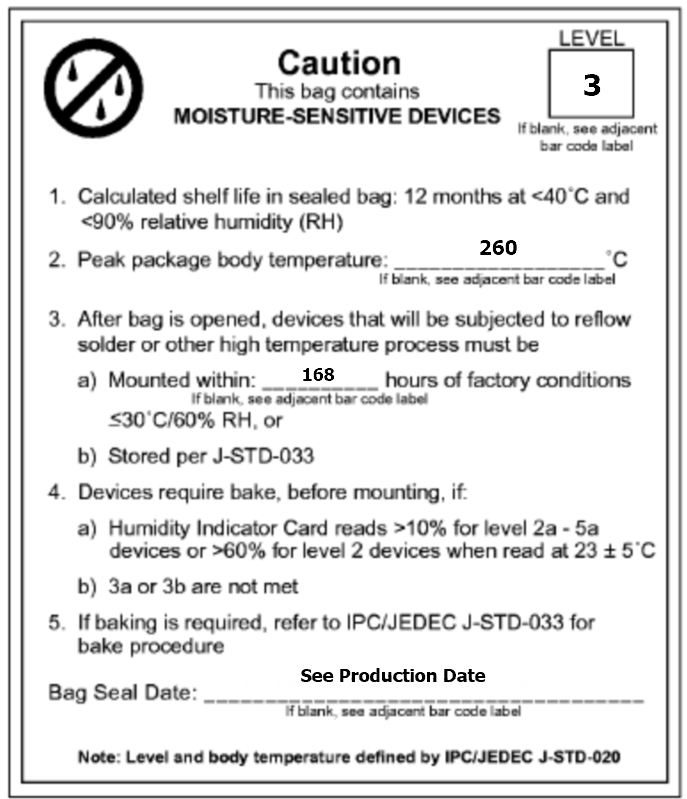
MOQ and packaging information
| Product model | MOQ (pcs) | Shipping packaging | Modules per reel (pcs) | Reels per carton |
|---|---|---|---|---|
| CB2S-J | 4,400 | Tape and reel | 1,100 | 4 |
Appendix: Statement
FCC Caution: Any changes or modifications not expressly approved by the party responsible for compliance could void the user’s authority to operate this device.
This device complies with Part 15 of the FCC Rules. Operation is subject to the following two conditions: (1) This device may not cause harmful interference, and (2) this device must accept any interference received, including interference that may cause undesired operation.
Note: This device has been tested and found to comply with the limits for a Class B digital device, according to part 15 of the FCC Rules. These limits are designed to provide reasonable protection against harmful interference in a residential installation. This device generates, uses, and can radiate radio frequency energy and, if not installed and used following the instructions, may cause harmful interference to radio communications. However, there is no guarantee that interference will not occur in a particular installation.
If this device does cause harmful interference to radio or television reception, which can be determined by turning the device off and on, the user is encouraged to try to correct the interference by one or more of the following measures:
- Reorient or relocate the receiving antenna.
- Increase the separation between the device and receiver.
- Connect the device to an outlet on a circuit different from that to which the receiver is connected.
- Consult the dealer or an experienced radio/TV technician for help.
Radiation Exposure Statement
This device complies with FCC radiation exposure limits set forth for an uncontrolled rolled environment. This device should be installed and operated with a minimum distance of 20cm between the radiator and your body.
Important Note
This radio module must not be installed to co-locate and operate simultaneously with other radios in the host system except by following FCC multi-transmitter product procedures. Additional testing and device authorization may be required to operate simultaneously with other radios.
The availability of some specific channels and/or operational frequency bands are country-dependent and are firmware programmed at the factory to match the intended destination. The firmware setting is not accessible to the end-user.
The host product manufacturer is responsible for compliance with any other FCC rules that apply to the host not covered by the modular transmitter grant of certification. The final host product still requires Part 15 Subpart B compliance testing with the modular transmitter installed.
The end-user manual shall include all required regulatory information/warnings as shown in this manual, including “This product must be installed and operated with a minimum distance of 20 cm between the radiator and user body”.
This device has got an FCC ID: 2ANDL-CB2S-J. The end product must be labeled in a visible area with the following: “Contains Transmitter Module FCC ID: 2ANDL-CB2S-J”.
This device is intended only for OEM integrators under the following conditions:
The antenna must be installed such that 20cm is maintained between the antenna and users, and the transmitter module may not be co-located with any other transmitter or antenna.
As long as the 2 conditions above are met, further transmitter tests will not be required. However, the OEM integrator is still responsible for testing their end product for any additional compliance requirements required with this module installed.
Declaration of Conformity European Notice

Hereby, Hangzhou Tuya Information Technology Co., Ltd declares that this module product is in compliance with essential requirements and other relevant provisions of Directive 2014/53/EU,2011/65/EU. A copy of the Declaration of Conformity can be found at https://www.tuya.com.

This product must not be disposed of as normal household waste, in accordance with the EU directive for waste electrical and electronic equipment (WEEE-2012/19/EU). Instead, it should be disposed of by returning it to the point of sale, or to a municipal recycling collection point.
The device could be used with a separation distance of 20cm from the human body.
Is this page helpful?
YesFeedbackIs this page helpful?
YesFeedback





